A GRANITE Q UARRY
And this is the common gray limestone of which lime used in building is made. The large oven in which lime is burned is caled a lime-kiln. Did you ever see one? Can you tel how the lime is made?
Here are three pieces of marble. This piece is pure white. This is colored. It is marked by many strange forms, as you see in your mantel-pieces and table-tops. In this piece, you see many colored spots--mottled it may be caled.
Marble is beautiful when polished.
In what different ways have you seen marble used?
What parts of furniture are sometimes marble? Why is
it suitable for this? Is marble ever used for building
houses? Do you think it would be good for that
purpose? Why? Which, do you think, is the best of al
building stones? Why?
Marble and granite are the most beautiful and enduring
of al building stones.
Chalk is a variety of limestone. Could it be used as a
A MARBLE Q UARRY.
building stone? Is chalk harder or softer than other
stone?
You need not to be told the name of this dark stone. You could not get along wel in school without slate. Slate is easily split into thin plates, and has a smooth, firm surface.
Slate is used to write on. It is used in house building. What part of a house is sometimes slate? Think of other uses. Why is it useful for these purposes?
We must not forget brick in our talks about things that come out of the ground. Brick is not found in the earth, as the metals and stone are found; but it is made of clay, which is itself a www.gutenberg.org/files/12228/12228-h/12228-h.htm
59/73
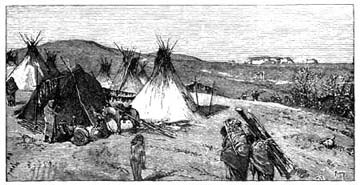
8/10/12
The Project Gutenberg eBook of Home Geography for Primary Grades
part of the ground.
Have you ever seen a brick-yard? What are some of the uses of bricks? What is the man
caled who builds houses of bricks?
Is glass taken out of a mine or quarry? No; but glass is made from sand; which is also a part of the ground.
In laying brick or stone, the mason uses mortar. Mortar is made chiefly of lime. Lime is made of stone which comes out of the ground.
If possible, visit mines and quarries. Take careful notice of al you see, and on your return to school tel what you have learned.
LESSON XLIII.
HOW PEOPLE LIVE AND WHAT THEY ARE DOING
Can you think of anything used in building houses that does not come from the earth?
Do al people have large, fine houses of brick or stone to live in? What is a tent?
WIGWAMS.
A wigwam? Who live in huts? Did you ever hear of people who live in snow houses?
www.gutenberg.org/files/12228/12228-h/12228-h.htm
60/73
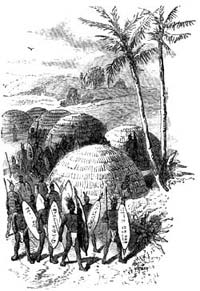
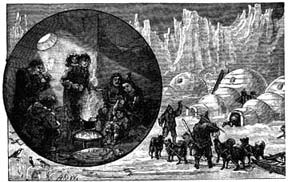
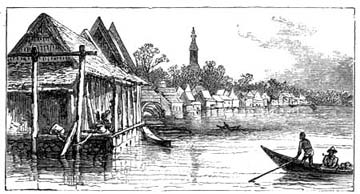
8/10/12
The Project Gutenberg eBook of Home Geography for Primary Grades
DID YO U EVER HEAR O F PEO PLE WHO LIVE IN
SNO W HO USES?
In some places houses are built of bamboo. Bamboo is a kind of cane that grows in warm
countries.
HO USES BUILT O F BAMBO O .
What building is now going up in this place? Tel the use of stone, brick, mortar, iron, tin, lead, and glass in building the house. Where and how are they obtained?
We could not live without food. We must also have
clothes to wear and houses to live in. Besides these,
we need schools, books, and churches, which make us
wiser and better. Now, if you think a little, you can
name many other things which we need to make our
homes beautiful. To supply us with al of these things,
men must do many different kinds of work.
Where does the food we eat come from?
We get most of it from plants. Wheat, corn, peas, and
beans are seeds of plants. Almost al our bread is
made from wheat. Beets, turnips, and radishes are
roots of plants. Lettuce and cabbage are the leaves of
plants.
WHO LIVE IN HUTS?
Apples,
www.gutenberg.org/files/12228/12228-h/12228-h.htm
61/73
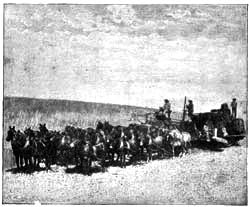
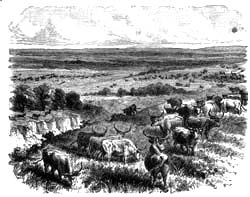
8/10/12
The Project Gutenberg eBook of Home Geography for Primary Grades
peaches, pears, and other fruits grow on
plants. Al these we use for food.
Plants also supply us with material for clothing.
Some clothes are made from cotton; cotton
grows in the pod of a plant. Some clothes are
made from linen; linen comes from flax, which
is a plant. Hats are made from straw; straw is
the stem or stalk of plants.
Now, these plants, which supply us with so
much of our food and clothing, do not grow of
O UR BREAD IS MADE FRO M WHEAT.
themselves.
The ground must be plowed, the seeds planted and taken care of while growing. So, outside
the city, you may see a great many people at work raising grain, vegetables, and other plants.
This occupation we cal agriculture or farming; the people we cal farmers.
Animals, as wel as plants, furnish much of our
food. Al meat comes from animals. We get
milk from cows. From milk we make butter
and cheese.
Animals also supply us with clothing. Many
articles of dress are made of wool. Wool, you
know, grows on the sheep. Shoes and kid
gloves are made of leather. Leather is made
from the hides of cows; sheep, oxen, and
goats.
But animals could not live and grow if people
did not carefuly raise them. In the country,
yon may see flocks of sheep and herds of
cows and oxen feeding on the fresh sweet
grass of the pastures. Those animals are caled
stock. The business of those who raise them is
HERDS O F CO WS AND O XEN FEEDING.
caled stock-raising.
Most farmers raise cows, horses, and other animals. Which land does the farmer use for
pasture? What is a pasture? What is a meadow?
Grazing means feeding on grass. What animals have you seen grazing? Does a dog graze? A
cow?
Mountains, so rough and rocky, are not good for farms and gardens. But many of them
contain coal, on which milions of people depend for heat and light. In mountains, too, we find iron, which is more useful to us than gold and silver.
www.gutenberg.org/files/12228/12228-h/12228-h.htm
62/73
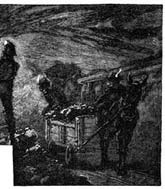

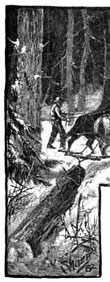
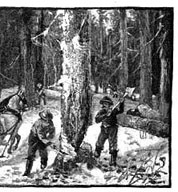

8/10/12
The Project Gutenberg eBook of Home Geography for Primary Grades
To get these, thousands of men are at work in
places caled mines. A mine is like a great cavern.
There is neither sun nor sky. Torches and lamps
give the only light the miners have to see by. The
air is damp and close. I suppose you would not
like to work in such a place. Yet great numbers of
persons are employed in mining.
How is coal taken out of a mine? What are the
dangers of coal-mining? Try to find answers to
these questions for yourself. If necessary, your teacher wil help you.
In some parts of the country are forests of pine, oak, and other trees. Some of these forests are so large we might travel for days or weeks through them. From trees we get lumber.
Lumber is needed for building houses and ships, and for furniture. So a great many men are employed in cutting down trees and preparing the wood for use. This is caled lumbering.
The lumbermen go into the woods in winter, and build themselves little huts to live in. Al through the winter months they work in the woods from sunrise to sunset, feling the best trees and cutting them into logs. Then they haul them over the snow-covered ground to the frozen streams, and pile them upon the banks.
Here the logs must rest til the snow and ice
have melted and the streams are ful. Then
they are floated down to the great saw-mils;
and cut up into boards, laths, shingles, and
other kinds of lumber.
What is a forest? Name some forest trees
that grow near your home.
The
sea yields much that we eat. Some
parts abound in codfish, mackerel,
and herring. Sardines, the little fish
that come in boxes, are also found in
the sea. It is the business of
thousands of people who live near the ocean to catch
fish, salt them, and pack them, to send to those who
want them for food.
IT IS THE BUSINESS O F
Have you ever seen the ocean, or eaten any of its fish?
THO USANDS O F PEO PLE.
Name some fishes found in fresh water.
Name some kinds of fishes found in waters near where you live. How may they be caught?
www.gutenberg.org/files/12228/12228-h/12228-h.htm
63/73
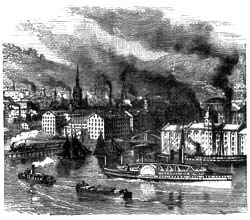
8/10/12
The Project Gutenberg eBook of Home Geography for Primary Grades
LESSON XLIV.
MORE ABOUT WHAT PEOPLE ARE DOING.
In the city or town we shal find many of the people busy about something else than the
occupations we have learned. What do you suppose it is?
If you go about the city, you wil see large buildings several stories high, with long rows of windows, and great smoking chimneys. These are mils or factories, ful of machines in motion doing their work almost like human beings.
The people who work in them make almost everything that is needed for our use. Wheat is
changed into flour; cotton, into thread, fine muslins, and pretty calicoes; leather, into boots and shoes; iron and steel, into plows, stoves; and cutlery; lumber, into wagons, carriages, and al kinds of furniture. Other articles which we must not forget are elegant jewelry, al sorts of ornaments for parlors, and beautiful toys which you admire so much.
It would take a long time to name a smal part
of the things made in the busy mils and
factories; but think of the articles used in your
home, and you may be sure they are
manufactured articles. You see,
manufacturing gives work to many thousands
of persons.
What is cutlery? Name some articles of
cutlery.
We need many things which we do not
produce. Other people need things which they
BUSY MILLS AND FACTO RIES.
do not produce. How can each obtain what he
needs? By exchanging one thing for another. This exchange of goods, or buying and seling
them for money; gives rise to another occupation caled trade, or commerce. So many people spend their time buying and seling grain, vegetables, clothing, boots and shoes, or in sending them to places where they are needed.
On al the large rivers and lakes you may see boats going up and down, carrying goods from
one part of the country to another.
Can you think how goods are carried from place to place where there are no rivers? In
countries where few people live, goods are often carried in wagons and on the backs of
animals.
I wonder how many people have to work to get food and clothing for us. Make a list of al
www.gutenberg.org/files/12228/12228-h/12228-h.htm
64/73
8/10/12
The Project Gutenberg eBook of Home Geography for Primary Grades
the occupations you can think of. Perhaps you can think of other occupations we have not
named. Is dressmaking an occupation? Teaching? Which occupation would you prefer?
Why?
If you think, perhaps you can tel why men do different kinds of work. What people do to
make a living, depends very much upon the place they live in. For men almost always do that kind of work that pays them best for their labor.
Those who live where the land is rich and level wil raise grain to make flour, or cotton and flax to make clothing. Some people among the mountains work in the mines. Some keep
cows for their milk and butter, and sheep for their wool; for the hils and many of the
mountain sides afford excelent pasture. People who live near the sea wil be apt to catch fish along the coast, or engage in trade upon the water.
Employments in the city differ widely from those in the country. Here, as we have learned, most people make their living by working in factories, or as merchants in buying and seling goods which come from al parts of the world.
Al people do not live in the same way. Some people have no churches, schools, books, or
factories.
What do people who live in this way eat? What do they wear? How do they spend their
time?
LESSON XLV.
A REVIEW LESSON.
What kind of work is done by the people among whom you live? Are they farmers? How
does the farmer make his living? Where does he sel the things which he raises? Where does
he buy his sugar and tea and other things which he needs?
Do you live in a city? What are the chief occupations of the people? Do they work in shops or mils or factories?
Name some mils or factories in or near your city. What articles are made there? What
manufactured articles are in the schoolroom? At home? What do you cal the men who make
these articles?
What kinds of goods are sold in the stores? What is a grocery store? A dry-goods store? A
shoe store? Where did the things in these stores come from? Which were made in your city?
Which were brought from other places?
www.gutenberg.org/files/12228/12228-h/12228-h.htm
65/73
8/10/12
The Project Gutenberg eBook of Home Geography for Primary Grades
What railroads or canals are in the city? Do boats come to the wharves? What do the boats
or railroads take away? What do they bring in return?
Write the following:
Farmers raise
(write the names of al the things you can think of).
Miners dig
out of the earth.
Quarrymen dig
from the quarries.
A shoemaker makes
.
A blacksmith makes
.
Merchants buy and sel
.
End of Project Gutenberg's Home Geography For Primary Grades, by C. C. Long
*** END OF THIS PROJECT GUTENBERG EBOOK HOME GEOGRAPHY FOR PRIMARY GRADES ***
***** This file should be named 12228-h.htm or 12228-h.zip *****
This and all associated files of various formats will be found in:
http://www.gutenberg.net/1/2/2/2/12228/
Produced by Charles Aldarondo, Keren Vergon, Ben Courtney and the
Online Distributed Proofreading Team.
Updated editions will replace the previous one--the old editions
will be renamed.
Creating the works from public domain print editions means that no
one owns a United States copyright in these works, so the Foundation
(and you!) can copy and distribute it in the United States without
permission and without paying copyright royalties. Special rules,
set forth in the General Terms of Use part of this license, apply to
copying and distributing Project Gutenberg-tm electronic works to
protect the PROJECT GUTENBERG-tm concept and trademark. Project
Gutenberg is a registered trademark, and may not be used if you
charge for the eBooks, unless you receive specific permission. If you
do not charge anything for copies of this eBook, complying with the
rules is very easy. You may use this eBook for nearly any purpose
such as creation of derivative works, reports, performances and
research. They may be modified and printed and given away--you may do
practically ANYTHING with public domain eBooks. Redistribution is
subject to the trademark license, especially commercial
redistribution.
www.gutenberg.org/files/12228/12228-h/12228-h.htm
66/73
8/10/12
The Project Gutenberg eBook of Home Geography for Primary Grades
*** START: FULL LICENSE ***















